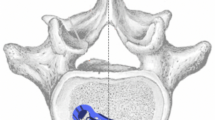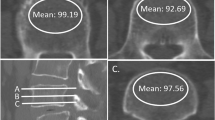Abstract
The availability of lumbar interbody cages has fuelled renewed interest in interbody fusion. Despite this, there is no consensus regarding the best non-invasive method for evaluation of interbody fusion, especially where cages have been used. The purpose of this study was to determine whether high-quality thin-slice (1- to 3-mm) computed tomography (CT) scans allow proper evaluation of interbody fusion through titanium cages. Patients undergoing lumbar interbody fusion were prospectively evaluated with CT scan and plain radiographs 6 months following surgery. These images were blindly and independently evaluated by a consultant radiologist and a spine research fellow, for bridging bony trabeculation both through and surrounding the cages as well as for changes at the cage endplate interface. Fifty-three patients (156 cages) undergoing posterior lumbar interbody fusion using titanium interbody cages were evaluated. Posterior elements were used to pack the cages and no graft was packed outside the cages. The outcome data were analysed using the Kappa co-efficient and chi-squared analysis. On CT scan, both observers noted bridging trabeculation in 95% of the cages (Kappa 0.85), while on radiographs this was present in only 4% (Kappa 0.74). Both observers also identified bridging trabeculation surrounding the cages on CT scan in 90% of cages (Kappa 0.82), while on the radiographs this was 8% (Kappa 0.86). Radiographs also failed to demonstrate all the loose cages. The results of the study show that high-quality CT scans show images suggesting bridging bony trabeculae following the use of titanium interbody cages. They also appear to show consistent bone outside the cages in spite of no bone graft having been used, and they appear to be better than plain radiographs in the early detection of cage loosening.




Similar content being viewed by others
References
Blumenthal SL, Gill K (1993) Can lumbar spine radiographs accurately determine fusion in postoperative patients? Correlation of routine radiographs with a second surgical look at lumbar fusions. Spine 18:1186–1189
Boden SD, Martin GJ, Horton WC, Truss TL, Sandhu SS (1998) Laparoscopic anterior spinal arthrodesis with rhBMP2 in a titanium interbody threaded cage. J Spinal Disord 11:95–101
Bosworth DM (1948) Techniques of spinal fusion: Pseudarthrosis and method of repair. AAOS Instructional Course Lecture 5:295–313
Brantigan JW, Steffee AD (1993) A carbon fibre implant to aid interbody lumbar fusion Two-year clinical results in the first 26 patients. Spine 18:2106–2117
Brantigan JW, Steffee AD, Lewis ML, Quinn LM, Persenaire JM (2000) Lumbar interbody fusion using the Brantigan I/F cage for posterior lumbar interbody fusion and the variable pedicle screw placement system: two year results from a Food and Drug Administration investigational device exemption clinical trial. Spine 25:1437–1446
Brodsky AE, Kovalsky ES, Khalil MA (1991) Correlation of radiologic assessment of lumbar spine fusions with surgical exploration. Spine [Suppl] 16:261–265
Cleveland M, Bosworth DM, Thompson FR (1948) Pseudarthrosis in the lumbosacral spine. J Bone Joint Surg Am 30:302–312
Cunningham BW, Kanayama M, Parker LM, Weis JC, Sefter JC, Fedder IL, McAfee PC (1999) Osteogenic protein versus autologous interbody arthrodesis in the sheep thoracic spine. Spine 24:509–518
Dunn G, Everitt B (1995) Clinical biostatistics. An introduction to evidence based medicine. Edward Arnold, London
Eck KR, Bridwell KH, Ungacta FF, Lapp MA, Lenke LG, Daniel Riew K (2000) Analysis of titanium mesh cages in adults with minimum two year follow-up. Spine 25:2407–2415
Fagan AB, Cain CMJ, Hall DJ, Fraser RD (1999) Carbon fiber cages for anterior lumbar interbody fusion: a prospective study. In: Szpalski M, Gunzburg R, Pope MH (eds) Lumbar segmental instability.Lippincott Williams Wilkins, Philadelphia, pp 203–208
Fraser RD (1996) How to fuse the lumbar spine. Bull Hosp Joint Dis 55:158–161
Greenough CG, Taylor LJ, Fraser RD (1994) Anterior lumbar fusion: results, assessment techniques and prognostic factors. Eur Spine J 3:225–230
Hacker RJ (1997) Comparison of interbody fusion approaches for disabling low back pain. Spine 22:660–666
Herzog RJ, Marcotte PJ (1996) Assessment of spinal fusion. Critical evaluation of spinal fusion. Spine 21:1114–1118
Holte DC, O'Brien JP, Renton P (1994) Anterior lumbar fusion using a hybrid interbody graft. A preliminary radiographic report. Eur Spine J 3:32–38
Kozak JA, O'Brien JP (1990) Simultaneous combined anterior and posterior fusion. An independent analysis of a treatment for the disabled low-back pain patient. Spine 15:322–328
Kuslich SD, Ulstrom CL, Griffith SL, Ahern JW, Dowdle JD (1998) The Bagby and Kuslich method of lumbar interbody fusion. History, techniques, and 2-year follow-up results of a United States prospective multicenter trial. Spine 23:1267–1279
Laasonen EM, Soini J (1989) Low back pain after lumbar fusion. Surgical and CT analysis. Spine 14:210–216
Lang P, Genant HK, Chafetz N, Steiger P, Morris JM (1988) Three dimensional computed tomography and multiplanar reformations in the assessment of pseudarthrosis in posterior lumbar fusion patients. Spine 13:69–75
Larsen JM, Rimoldi RL, Capen DA, Nelson RW, Nagelberg S, Thomas JC Jr (1996) Assessment of pseudarthrosis in pedicle screw fusion: a prospective study comparing plain radiographs, flexion/extension radiographs, CT scanning, and bone scintigraphy with operative findings. J Spinal Disord 2:117–120
Leufven C, Nordwall A (1999) Management of chronic disabling low back pain with 360 degrees fusion. Results from pain provocation test and concurrent posterior lumbar interbody fusion, posterolateral fusion, and pedicle screw instrumentation in patients with chronic disabling low back pain. Spine. 24:2042–2045
McAfee PC (1999) Interbody fusion cages in reconstructive operations on the spine. J Bone Joint Surg Am 81:859–880
McAfee PC (ed) (2001) Symposium. A critical discrepancy—a criteria of successful arthrodesis following interbody spinal fusions. Spine 26:320–334
McAfee PC, Regan JJ, Peter Geis W, Fedder IL (1998) Minimally invasive anterior retroperitoneal approach to the lumbar spine. Emphasis on lateral BAK. Spine 23:1476–1484
Pearcy M, Burrough S (1982) Assessment of bony union after interbody fusion of the spine using a biplanar radiographic technique. J Bone Joint Surg Br 64:228–232
Ray CD (1997) Threaded titanium cages for the lumbar interbody fusions. Spine 22:667–680
Rothman SLG, Dobben GD, Rhodes ML, Glenn WV, Azzawi Y (1984) Computed tomography of the spine: curved coronal reformations from serial images. Radiology 150:185–190
Stauffer RN, Coventry MB (1972) Anterior interbody lumbar spine fusion. J Bone Joint Surg Am 54:756–768
Weiner BK, Fraser RD (1998) Spine update. Lumbar interbody cages [published erratum appears in Spine 1998; 23:1428]. Spine 23:634–640
Yashiro K, Homma T, Hokari Y, Katsumi Y, Okumura H, Hirano A (1991) The Steffee variable screw placement system using different methods of bone grafting. Spine 16:1329–1334
Acknowledgement
The authors acknowledge the statistical advice given by Dr. Richard Morris, Department of Primary Care and Population Sciences, Royal Free & University College Medical School, London, UK.
Author information
Authors and Affiliations
Corresponding author
Additional information
The work for this study was carried out at the Spinal Surgical Unit of the Royal National Orthopaedic Hospital. No financial support of any kind has been received from any party for the purpose of this study
Rights and permissions
About this article
Cite this article
Shah, R.R., Mohammed, S., Saifuddin, A. et al. Comparison of plain radiographs with CT scan to evaluate interbody fusion following the use of titanium interbody cages and transpedicular instrumentation. Eur Spine J 12, 378–385 (2003). https://doi.org/10.1007/s00586-002-0517-4
Received:
Revised:
Accepted:
Published:
Issue Date:
DOI: https://doi.org/10.1007/s00586-002-0517-4




